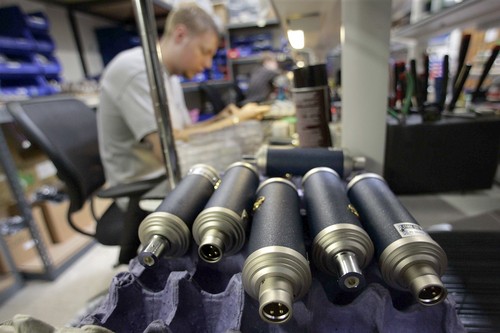
 January 15, 2009
January 15, 2009
Celebrity battle over access ends — for now
A judge rules that ‘guests and invitees’ of South Beverly Park residents can enter the exclusive Westside community through the gates of adjacent North Beverly Park.
By Martha Groves
Los Angeles Times Staff Writer
In a decidedly uncivil war of haves versus haves, the South has prevailed against the North.
South Beverly Park, that is.
A Los Angeles County Superior Court judge tentatively ruled this week that “guests and invitees” of residents of the exclusive Westside community may enter through the gates of adjacent North Beverly Park.
The dispute went to court last spring after the 64-home North Beverly Park Homeowners Assn. began restricting access to a road that residents of the 16-home South Beverly Park neighborhood had been freely using for two decades.
Under the limitations, southern residents could continue to use the northern gates at Mulholland Drive.
But their nannies, gardeners and contractors had to take long detours on Benedict Canyon or Coldwater Canyon drives.
Northern residents defended the restrictions, citing security concerns and costs.
Among the South Beverly Park plaintiffs were Earvin “Magic” Johnson, Samuel L. Jackson and producer Richard Zanuck.
The northern defendants included Denzel Washington, Reba McEntire and media moguls Haim Saban and Sumner Redstone.
The battle is not over, said Jeffrey G. Huron, an attorney for the northern residents.
“It’s our intention to file written objections,” he said.
Huron added that the communities are separate and distinct.
“There is no reason why [southern] guests and invitees should not have to use the public streets like all of the other residents in the neighborhood that do not live in North Beverly Park,” he said.
Steve Goldberg, an attorney for the southern residents, said he expected the decision to stand.
If and when the ruling becomes final, he said, his clients intend to launch Phase 2: a claim for compensatory and punitive damages.
Goldberg said they also would seek reimbursement for attorney fees of $2 million and counting.
martha.groves@latimes.com

 November 20, 2008
November 20, 2008
Hollywood stars sue over access to a neighborhood gate
Samuel L. Jackson, Denzel Washington, Eddie Murphy, Reba McEntire, Sylvester Stallone, Magic Johnson and Barry Bonds are involved in the lawsuit between North and South Beverly Park homeowners.
By Martha Groves
Los Angeles Times Staff Writer
A gated domain of sports stars, A-list actors, media billionaires and nouveau riche Angelenos — where 11,000 square feet constitutes a “cozy” house and a developer once built a $20-million manse on spec — is embroiled in a legal fracas that shows once and for all that money can’t buy happiness.
The court battle began in May, when residents of South Beverly Park sued their confreres in North Beverly Park.
These aren’t just any residents.
Among the South Beverly Park plaintiffs are Earvin “Magic” Johnson, Samuel L. Jackson and movie producer Richard Zanuck and his wife, Lili.
The North Beverly Park defendants include Denzel Washington, Eddie Murphy, Reba McEntire, Sylvester Stallone, Barry Bonds and media moguls Haim Saban and Sumner Redstone.
The dispute was touched off when the 64-home North Beverly Park Homeowners Assn. began restricting access to a road that residents of the 16-home South Beverly Park community had been freely using for two decades.
Under the new restrictions, the southern residents themselves could continue to enter through the northern gates at Mulholland Drive. But their contractors, nannies and gardeners, according to residents, had to take detours as long as seven miles on Benedict Canyon or Coldwater Canyon drives.
The communities, which carry a Beverly Hills post office address, are actually part of the city of Los Angeles. They are nestled between Mulholland Drive and Sunset Boulevard and Coldwater Canyon Drive and Beverly Glen Boulevard.
Within the gates are enormous mansions — in Tuscan, French chateau, Spanish and modern styles — set on large, flat lots of 1 to 3.5 acres. Of the handful of houses on the market, the most expensive is in the north, with an asking price of $50 million. The cheapest is $14 million.
Even the small and cheap mansions feature security gates and high stone walls, impeccably manicured lawns, tennis courts and pools.
“It’s a super unique enclave that gives you complete security, living among your peers,” said Mauricio Umansky, a real estate agent with Hilton & Hyland. “From every aspect, it’s just fantastic.”
Brian Adler, who helped develop the sister communities beginning in the mid-1980s, said the concept of having guards and gates was intended to make Beverly Park stand out from the other three top Westside neighborhoods, Beverly Hills, Holmby Hills and Bel-Air.
“It made sense that the highest-profile people would take interest,” Adler said.
For more than 20 years after the north gates were installed, according to South Beverly Park’s complaint, residents of the dual communities “enjoyed placid and neighborly relations.” All residents of South Beverly Park and their relatives, guests and “business invitees” had undisturbed access to the homes from the north.
In March 2006, the North Beverly Park homeowners group sent the south’s homeowners a letter demanding that they “pay their fair share of costs we [the north association] are incurring for maintenance of the roads, gates and security.” The amount specified was $121,000 a year.
Southern residents rejected the demand, and a volley of legal correspondence ensued, culminating in the northern group’s raising the amount it sought to $128,000, according to the complaint.
In May 2007, the northern residents informed their southern neighbors that their relatives, “staff, vendors and guests” would no longer be allowed to enter the northern neighborhood’s gates at Summitridge and Mulholland drives.
Plaintiffs stated in the complaint that the prohibition could result in absurd situations, such as denied access to a fiancee, grandparent or domestic partner of a South Beverly Park resident. The complaint added that construction vehicles, which were required to enter via the north gate at Mulholland, would be locked out of South Beverly Park because they could not navigate the narrow, steep streets above Sunset Boulevard.
The complaint said the conditions, covenants and restrictions for both the south and north developments “made clear that all of the residents of both . . . were to have free and full access through the north gates.” That provision, it added, “represented a valuable property right” for each South Beverly Park homeowner.
The restriction, the complaint said, thus diminished the value of properties in South Beverly Park, in addition to severely inconveniencing plaintiffs’ relatives, friends and others.
Steven Goldberg, an attorney for the plaintiffs, declined to comment. Jeffrey Huron, an attorney for the defendants, could not be reached.
Attorneys are expected to make their closing arguments Friday in Santa Monica Superior Court before Judge Norman P. Tarle.
One northern resident defended the restriction, citing security. “We don’t know these workers,” said Irena Medavoy, wife of movie producer Mike Medavoy. “We don’t know who’s coming in.” She added that requiring payment from southern residents was only fair, given that she and her neighbors in the north pay a few thousand dollars a month for security.
Medavoy, who considers her 11,000-square-foot East Coast traditional to be the small house on the block, sang the praises of Beverly Park, calling it a “wonderful place to live, with really terrific families.”
“We’re going to have to add extra security,” she said. “You have to stop them, know who’s coming through. We videotape them. Then you have the patrol cars.” Referring to Israel’s famed national intelligence service, she added: “It’s like Mossad security here.”

 August 13, 2008
August 13, 2008
Former Tennis Star Tracy Austin Accuses Broker Gary Fournier of Fraud
In a lawsuit, she says the L.A. investment broker inflated his commissions and ‘churned’ accounts to generate fees. He denies wrongdoing.
By Kim Christensen
Los Angeles Times Staff Writer
Former tennis champion Tracy Austin on Tuesday joined an all-star cast of sports figures in accusing a prominent Los Angeles investment broker of defrauding them.
In a civil lawsuit filed in Los Angeles County Superior Court, Austin and her husband, Scott Holt, alleged that Gary R. Fournier charged excessive commissions on bond trades and “churned” their accounts to generate fees from unnecessary transactions.
The couple claims damages “in excess of $500,000” on the trades, which allegedly occurred from 1994 to 2002, while Fournier worked for Salomon Smith Barney Inc. in Los Angeles. Its successor firm, Citigroup Global Markets Inc., also is named as a defendant.
Fournier, an investment advisor for more than 30 years, has denied wrongdoing. Citigroup declined to comment.
A member of the International Tennis Hall of Fame, Austin, 45, became the youngest U.S. Open champion in history in 1979 at age 16. She won the title again two years later and was ranked No. 1 in the world before her career was cut short by injuries.
Her allegations mirror those previously made against Fournier by other sports figures, including Los Angeles Lakers great Jerry West and General Manager Mitch Kupchak; former National Basketball Assn. players B.J. Armstrong and Stacey Augmon; and former Major League Baseball players Sean Douglass and Rex Hudler, now a member of the Angels broadcast team.
In a claim filed in 2007 with the Financial Industry Regulatory Authority, the investment industry group that licenses and regulates brokers, West and the others alleged that Fournier charged excessive commissions and churned accounts involving $300 million in trades he executed from 2002 to 2006 while with UBS Financial Services Inc. Sports agent Arn Tellem and his wife, Nancy Tellem, president of CBS Paramount Network Television Entertainment Group, are among those who claimed that Fournier gouged them to the collective tune of $3 million.
Their claim, which focused on Fournier’s actions but did not name him as a party to the case, is set to be heard by a three-member arbitration panel in September. It seeks unspecified damages from UBS, which has denied the allegations.
“Mr. Fournier has done nothing but look out for the financial interests of all of his clients and expects to be fully vindicated in the upcoming FINRA arbitration hearing,” said his lawyer, Michael Blumenfeld.
He called the allegations “unfounded and meritless” and said that “both the timing of Ms. Austin’s lawsuit and its filing in the Los Angeles Superior Court are highly suspect.”
“Any lawyer who commonly practices in this area of the law knows that Ms. Austin is required to pursue her claims before a securities arbitration tribunal — and cannot proceed in state or federal court,” he said. “The court filing therefore suggests nothing more than a litigation tactic.”
Attorney Steven M. Goldberg, who represents Austin and her husband, as well as West and the others, called Blumenfeld’s comments “desperate and preposterous” and contends the lawsuit was properly filed.
Arbitration panels can hear only matters that have occurred within the last six years, he said, whereas the statute of limitations for the court starts when the alleged wrongdoing is discovered.
Austin and her husband learned of the alleged fraud after reading a Los Angeles Times story about the West case in April, according to their lawsuit.

 August 13, 2008
August 13, 2008
From the Los Angeles Times
BUSINESS NEWS
Blue Microphones turns up the volume Los Angeles Times Staff Writer
Making audio tools for mainstream laptop users is instrumental to its success. Apple nudged it to develop the Snowball USB mic, which became a hit with users of recording software such as GarageBand.

Microphone bodies point at assembly engineer Jordan Butcher as he works on a hand-built
piece. Blue Microphones still makes the studio mics that built its reputation.
By Nathan Olivarez-Giles
July, 21, 2008
Blue Microphones got its start building high-end studio microphones for the recording industry, making a name for itself as a niche player. But niche no more. With a nudge from Apple Inc., the Westlake Village company built a low-cost microphone for use with music recording software. That mic, called the Snowball, has become a hit with aspiring pro musicians and dedicated hobbyists who make demo recordings on their laptops instead of shelling out $50 an hour or more for studio time. The company projects $10 million in sales this year, double what it did last year and up from $3 million in 2007. What’s more, its higher profile helped draw the attention of Los Angeles private equity firm Transom Capital Group, which bought Blue from founders Skipper Wise and Martins Saulespurens for an undisclosed amount in April 2008. Transom is betting that Blue will expand its market beyond the musicians who have taken it this far. Its products can be used to record podcasts, soundtracks for videos and audio for videoconferences. It also offers an HD webcam.
“Blue is in the position to take recording from this rarefied thing only recording artists know about to something that can integrate into your life just as much as your digital camera does,” said Russ Roenick, a managing director at Transom. “A child can use our mics or an 18-year-old can upload their video and audio on Facebook.”
That vision is dramatically different from what the company founders had in mind when they started Blue Microphones in 1995.
Then, Wise was a jazz musician recording and producing for companies including Cypress Records. He had met Saulespurens during recording sessions in Europe in the mid-1980s, when Saulespurens was an audio engineer at the Latvian Conservatory of Music.
Saulespurens found his way to the States, and the two men started Blue on a shoestring budget a few years later, at first repairing vintage microphones from the 1950s and ’60s and then advancing to building their own mics.
The name “Blue” is a tip of the hat to Saulespurens’ homeland: It’s an acronym for Baltic Latvian Universal Electronics.
“I just wanted Latvia in the name somewhere,” Saulespurens said.
“Skipper said the name just had to be easy to remember, so he said, ‘Blue, let’s just call it Blue.’ ”
The company’s high-quality mics were well regarded within the recording industry, enough so that when Apple was getting ready to launch its GarageBand recording software, a programmer sent Wise an early copy.
“They were concerned about the sounds that would be going into GarageBand,” Wise said. “If you use a bad microphone to record anything, you get bad sound — garbage in, garbage out.”.
After testing some USB microphones on the market, Wise said, he knew Blue could do better.
“At that time, nobody on the professional recording side of music was thinking about consumer electronics, and nobody on the consumer side was thinking about music,” he said.
“But after using the software, I knew this was going to change everything. GarageBand changed the type of business Blue is.”
Wise said Apple’s global supply manager, Pete Lacey, encouraged them to put the computer mic into production, and the Snowball was born. Lacey and his colleagues at Apple also pushed to stock the mics in Apple’s stores, Wise said.
“Apple stores provide exposure to an affluent buyer, a discriminate buyer, someone who is more likely than the average PC user to be interested in digital media and creating media,” said Ross Rubin, a consumer electronics analyst with NPD Group.
“Apple has supported Blue, and Blue has supported the Mac and the iPod, and they’re reaping the rewards of coming to market early with their consumer microphones.”
Since the Snowball hit shelves in 2005, Blue says, it has sold 300,000 of the $99 white, softball-size USB mics. Blue also makes other mics, and in addition to its website and the Apple Store, its products can be found at Best Buy, Fry’s Electronics, Guitar Center and other stores. One of its newest products is the Mikey, which plugs into iPods and iPhones, records in stereo and sells for $79.
As the company grew, Wise and Saulespurens found they needed help running the business. An attorney friend introduced them to Roenick and others at Transom, which took a majority stake last year. Transom took over Blue’s day-to-day operations, doubled its employees to about 50, and has invested in new product development with an eye toward expanding the company’s consumer range, Wise said.
Wise, as president, and Saulespurens, as chief engineer, run the creative side of the company, develop new products and hold a minority share.
Blue remains committed to the hand-built studio mics that built the company’s reputation and sell for as much as $10,000, but the future of the microphone manufacturer lies with the mainstream, Wise said.
“There are more than 9 million artists on MySpace,” he said.
“The majority of them don’t record in a full studio but record at home. So what people need more than ever are good, affordable microphones.”

 January 15, 2009
January 15, 2009
